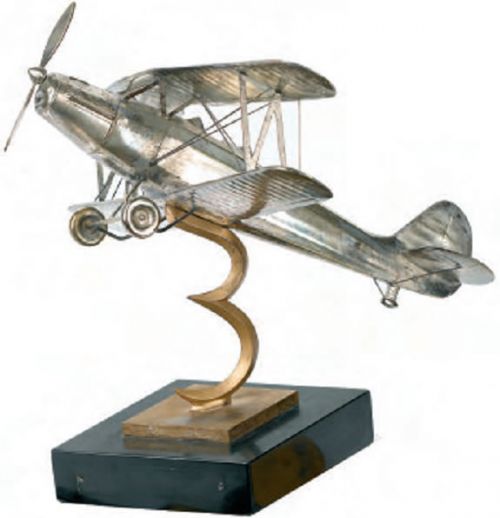
Model of a Gotha Go 145 biplane trainer
Unmounted (ref: 2590)
Copper alloy, silvered, mounted on a marble base with a gilded pedestal,
13 1/2 x 13 1/2 in., base 5 1/2 x 5 1/2 in. (34.3 x 34.3 cm., base 14 x 14 cm.)
Tags: Albert Kalkert sculpture war

Copper alloy, silvered, mounted on a marble base with a gilded pedestal,
13 1/2 x 13 1/2 in., base 5 1/2 x 5 1/2 in. (34.3 x 34.3 cm., base 14 x 14 cm.)
Tags: Albert Kalkert sculpture war
Literature: J.R. Smith, German Aircraft of the SecondWorldWar, Putman, NewYork, and Bodley Head, London, 1972, pp. 215–16.
Gotha
aircraft gained notoriety during the FirstWorldWar as the first
aeroplane to drop bombs (from autumn 1916 onwards), succeeding the
cumbersome Zeppelin on air raids. After the war , as part of theTreaty
ofVersailles, all surviving Gotha aircraft were destroyed.When the Gotha
Company was re-established in October 1933, its first aircraft was the
Go 145 biplane trainer, designed by Albert Kalkert. It is likely that
this model was made to commemorate the event.The plane was made out of
wood with a fabric covering, featured fixed landing gear and was powered
by an Argus As 10C air-cooled engine fitted with a two-blade
fixed-pitch propeller .The first prototype took to the air in February
1934, and was followed by a production model, the Gotha Go 145A, a
dual-controlled trainer with flight controls in the rear seat.
In
1935 the Gotha Go 145 started service with Luftwaffe training units.The
aircraft proved a successful design, and production of the Go 145 was
taken up by other companies, including AGO, Focke-Wulf and BFW. Licensed
versions were also manufactured in Spain andTurkey.The Spanish version,
called the CASA 1145-L, remained in service until long after the Second
WorldWar .